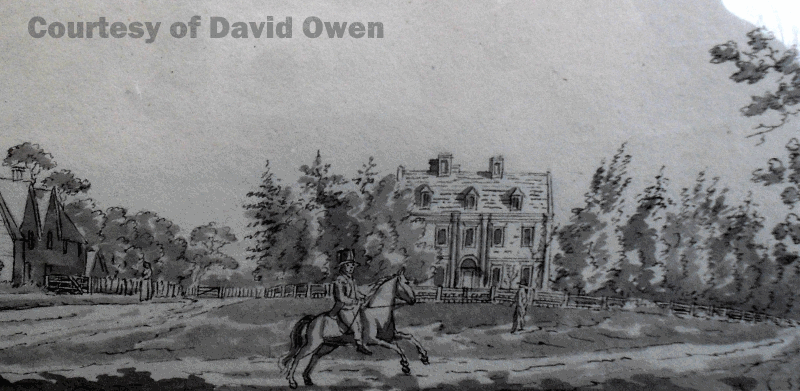The wealthiest man in Sutton in 1676 was Henry Pudsey of Langley Hall. On his death in 1677 half his estate was bequeathed to his eldest daughter Elizabeth (then aged 10), who later married Henry Lord Ffolliott - this half of the estate included property at Four Oaks. The property consisted of Doe Bank House (which stood on the corner of Wentworth Road and Lichfield Road) and land to the north. Lord Ffolliott may have stayed at Doe Bank House to supervise the building of Four Oaks Hall, but he resided mainly at another house, Castle Bromwich Hall.
Doe Bank House was part of the Four Oaks Hall estate, which was sold to Sir E.C.Hartopp in 1792 for £12,000. His eldest son, George H. Fleetwood Hartopp, adapted Doe Bank House as a bacheler residence for himself; soon after he became MP for Dundalk, and Gerard Gosselin moved in. Gosselin was an army officer, probably a friend of Sir E.C.Hartopp, who supported Gosselin’s election to the Warden and Society in 1800 and to the office of Warden in 1802 and 1803. His father, Joshua Gosselin, was an artist well known for his prints of country seats, and it must have been on a visit to his son that the only known illustration of Doe Bank House was drawn.
Gosselin resigned as Warden and “departed out of this town” in October 1804. No doubt duty called, he reached the rank of Colonel in 1810 and major general in 1813 (then aged 44). In the American war of 1812 he captured half the state of Maine, re-named New Ireland, which he governed for a while before it was handed back to the USA, then in 1814 he attacked and captured Genoa, which he also governed until Napoleon’s overthrow; he died at his seat, Ospringe Mount, Faversham, Kent in 1859.
Doe Bank House continued to be let on an annual basis until the Four Oaks Estate was offered for sale in 1864; the sale catalogue describes Doe Bank House as “formerly the dower house of the estate”. On the ground floor were entrance hall, dining room, library and “domestic offices”, the first floor had a drawing room, nursery and four good bedrooms, and there were another eight bedrooms on the upper floor. It was in the occupation of Edward Peyton Esq., a yearly tenant paying £100 per annum - he lived there in style with his wife, five children, a footman, a cook, a housemaid, a seamstress and a groom. He employed 450 workers at his Bordesley bedstead works.
Now known as the Dower House, the occupant in the 1950s was J.M.Antrobus, who described the house as a mixture of styles. The steep-pitched brick gables were, he thought, Elizabethan, while the south elevation appeared to be “late Restoration”, perhaps the work of William Wilson, Lord Ffolliott’s step-father-in-law. A three-sided bay at the end of the south elevation was late Georgian in style, probably done in the 1790s for George Hartopp’s bachelor residence. Doe Bank House was demolished in 1965 and the six houses in Hampton Drive were built on the site of the house and its grounds.
